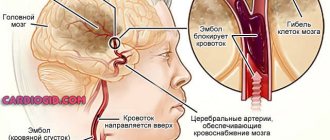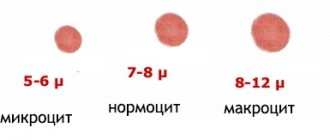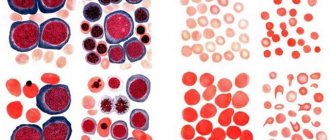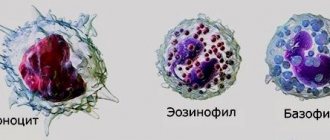General information
Platelets are granulocytic blood cells without a biconvex nucleus, formed from plasma cells of the bone marrow. They are presented in different forms - young, adult and mature. The diameter is directly proportional to age: 2-4 microns. Platelets contain granules that create blood clotting proteins, lytic enzymes, phosphatase and cathepsin, create serotonin, calcium ions and ATP, and contain lysosomal enzymes.
One of the most important functions of blood platelets is participation in blood clotting (primary hemostasis).
Platelets bind clotting factors, making blood clots thicker. As a rule, in an inactive state, when the vessel wall is damaged, platelets are directed to the damaged area. Thanks to the pseudopods located on the surface of the body, they are attached to each other and the vascular wall, forming a blood clot, which is an excellent barrier to bleeding. In the active state, platelets are able to change the shape of the body, due to which they increase their area, and this allows them to completely close the damage.
In addition, platelets are able to protect the body from foreign bodies by catching them with the help of pseudopods, and then digesting them with the help of the enzyme lysocine, which is formed from platelet factors (thrombin, thromboxane), from platelet granules. Thus, platelets are important for the immune response, being “killer” cells for foreign agents entering the body.
Blood plates serve as a storage site for serotonin, providing antitumor and radioprotective effects.
Thus, a violation of the number of platelets leads to inhibition of their functions, this certainly leads to disruption of the body’s activity and entails negative symptoms.
Normal platelet count in blood
The number of platelets in the body should normally vary from 180 to 320*10^9 for women and from 200 to 400*10^9 for men per liter of blood. Moreover, the number of platelets in women can change during menstruation to 75 * 10^9 per liter of blood, can decrease in the third trimester in pregnant women and, regardless of gender, increase in response to an inflammatory reaction, which seems to be a physiological norm and is not a deviation, without carrying negative symptoms.
In children, the normal platelet count depends directly on the age of the child. For a newborn, the norm will be 100-420*10^9 per liter of blood, and at two weeks of age and up to a year it is 150-350*10^9 per liter of blood. Up to five years, the amount changes slightly to 180-350*10^9 per liter of blood. By the age of seven, the norm reaches 180-450*10^9 per liter of blood.
For prevention, you need to take a blood test at least once a year in order to identify a possible pathology as early as possible and begin its treatment as soon as possible at an early stage, before the development of a severe clinical condition. If a deviation is detected, a blood test is performed more often.
They live in the body for only 9-10 days, after which they are renewed, destroyed in the liver or spleen and re-proliferate in the bone marrow.
Transcription of analyzes online.
cost of service: 500,300 rubles
Order
General practitioner Khanova Irina Ivanovna will interpret your tests during an online call in the Zoom or WhatsApp application.
- detailed explanation from the general practitioner.
- an alternative opinion from a competent specialist in interpreting the analyses.
- the opportunity to ask questions to the doctor regarding test results.
Causes of low platelet count in blood test
A decrease in the number of platelets in a general blood test below normal to 150*10^9 per liter of blood and below is a pathological condition and is called “thrombocytopenia”. Since this is a condition, not a disease, it only characterizes, being a symptom of a specific disease.
There can be many reasons for a decrease in platelets, and they are all different from each other, so it can sometimes be very difficult to name one at once.
The main causes of thrombocytopenia are:
- Increased platelet destruction.
- Increased platelet consumption.
- Insufficient platelet production.
These three conditions can be the result of an inherited condition in which enzyme activity is impaired, but more often it is an acquired condition due to:
- Suppression of bone marrow activity.
- Hemoblastosis (tumor disease of hematopoietic or lymphoid tissue).
- Disseminated vascular coagulation syndrome (due to various bacterial infections or brain injury).
- Vitamin B12 deficiency.
- Folic acid deficiency.
- Hypersplenism syndrome (an increase in the size of the spleen, as well as an increase in the destruction of blood cells).
- Hemorrhagic diathesis (increased bleeding).
- Immune thrombocytopenia.
- Thrombocytopenic purpura.
- Leukemia (malignant disease of the bone marrow, otherwise called blood cancer).
- Paroxysmal nocturnal or cold hemoglobinuria.
- Collagenosis (connective tissue damage).
Additional reasons for a decrease in platelets in the blood may also be:
- Violation of medication regimen (vancomycin, heparin, sulfamethoxazole, drugs for the treatment of diabetes mellitus).
- Use of chemotherapy drugs.
- Massive blood transfusion.
- Cirrhosis of the liver.
- Myelofibrosis.
- Hepatitis C virus.
- Human immunodeficiency virus (HIV).
- Epstein-Barr virus (infectious mononucleosis).
- Hyperthyroidism.
- Hypothyroidism.
- Hemolytic-uremic syndrome.
- Alcoholism.
Platelets: friends or enemies?
Today we will talk about cells, life without which, without exaggeration, would be impossible.
Galina Petrovna Episheva, a therapist at the Expert Clinic Kursk, talks about platelets.
— Galina Petrovna, what are platelets?
— This is one of the types of blood cells (along with red blood cells and leukocytes). Sometimes they are also called blood platelets. The diameter of the platelet is small - only 2-3 microns. It has no core. The platelet contains a large number of granules containing substances of various chemical compositions.
Platelets are produced by red bone marrow, their predecessors are large bone marrow cells - megakaryocytes.
— What is the role of platelets in the body?
— Today the following functions of platelets are known:
- they protect the walls of blood vessels from mechanical damage;
- prevent blood loss;
- nourish blood vessels;
- participate in the regeneration (restoration) of damaged tissues.
There are also reports that platelets have some antiparasitic effects.
— What is the platelet rate in humans?
— The platelet count is measured in thousands per 1 μl (microliter) of blood (the measurement in liters is also used). The norm is determined depending on gender:
- for men – 200-400 thousand/µl (or, otherwise, 200-400x109/l);
- for women – 180-320 thousand/µl. During menstruation, the rate may decrease, ranging from 75 to 220 thousand/μl. A decrease can also be observed during pregnancy - approximately 100-310 thousand / μl.
In children, the platelet count changes according to age.
Please note that the normal platelet count in the blood may vary depending on the specific laboratory in which the analysis is performed.
— If platelets are increased or decreased, what does this mean? What can lead to an increase or decrease in their number?
— The reasons for the increase in platelets may be:
- stress;
- physical overload;
- use of certain medications (increased platelet count as a side effect). For example, these could be corticosteroids, adrenaline;
- injuries (fracture, cuts, burns);
- erythrocytosis;
- some types of leukemia (leukemia);
- a number of infections;
- enteritis;
- pneumonia;
- acute meningitis;
- anemia;
- autoimmune diseases (rheumatoid arthritis, sarcoidosis, vasculitis);
- cirrhosis of the liver;
- splenectomy.
Reasons for a decrease in platelet count may include:
- pregnancy;
- idiopathic thrombocytopenic purpura (Werlhof's disease);
- use of a number of medications (decreased platelet count as a side effect). For example, these could be antidepressants, antibiotics;
- oncopathology, including tumors of the hematopoietic system;
- chemotherapy;
- hypothyroidism and hyperthyroidism;
- bleeding;
- severe injuries;
- long menstruation;
- liver diseases (in particular hepatitis);
- surgical interventions;
- avitaminosis;
- poisoning with alcohol, heavy metals;
- HIV infection.
— Does it happen that the number of platelets is normal, but their functions are impaired?
- Yes. Platelet dysfunction can result from many causes. I will list some:
- mutation of genes responsible for platelet membrane glycoproteins. This happens, for example, with thrombasthenia - Bernard-Soulier disease;
- abnormalities of platelet granules, in particular, deficiency of dense granules containing ATP, calcium, serotonin;
- changes in the function of cytosolic enzymes, other platelet proteins and a number of others.
— How to identify problems with platelets, in particular, changes in their number and function?
— A number of studies are being carried out. Among them:
- complete blood count with platelet determination;
- coagulogram (blood clotting test);
- study of platelet aggregation.
You can read more about a general blood test in our article
— For what pathological processes and conditions is a platelet test prescribed?
— The list of them is extensive. This:
- injuries;
- thrombosis and thromboembolism;
- blood loss;
- anemia and erythrocytosis;
- leukemia, lymphogranulomatosis, other oncological pathologies;
- poisoning;
- enteritis;
- liver diseases;
- hypo- and hyperthyroidism;
- hypersplenism (increased spleen function);
- prolonged menstruation;
- alcoholism;
- chemotherapy.
— What complaints and signs can be a reason to study the number and functions of platelets?
— The appearance of hemorrhages/bruises (“bruises”) on the skin and/or mucous membranes is typical, and not necessarily associated with even a minor injury. In other words, they can arise spontaneously. The patient may also experience bleeding gums and possible nosebleeds. In women, the duration of menstruation increases.
— How to properly prepare for a platelet test?
— If we are talking about determining the number of platelets in a general blood test, then this is:
- observing a 12-hour fast before donating blood;
- exclusion of fatty foods and alcohol on the eve of the study;
- 2 hours before taking blood, it is advisable to limit physical and emotional stress, stress; you should not smoke for half an hour.
— Which doctor should you contact if you have symptoms indicating a possible platelet problem?
- See a therapist, general practitioner or specialist - an otolaryngologist (for example, for nosebleeds), a gynecologist (for prolonged menstruation). Based on the results of the survey, examination and tests, a consultation with a hematologist or other specialist may be recommended.
You can make an appointment with specialists here
ATTENTION: the service is not available in all cities
Interviewed by Enver Aliyev
The editors recommend:
Leukocytes. What will a blood test tell you?
What does a biochemical blood test show?
Immunity is not on the side of Rosa Luxemburg and Clara Zetkin. Why doesn't nature recognize equality?
For reference:
Episheva Galina Petrovna
She graduated from the Faculty of General Medicine of Kursk State Medical University in 1990.
From 1990 to 1991 she completed an internship in therapy. Doctor of the highest category.
Currently a general practitioner at the Expert Clinic Kursk. Receives at the address: Karl Liebknecht St., 7.
Consequences of low platelet count
In a state of low platelet count, disorders subsequently develop, which include frequent bleeding (menstrual and nosebleeds), while the bleeding time increases significantly and becomes difficult to stop. Sudden gum bleeding may develop (not everyone does). Blood clots may be found in urine or stool. Petechiae (red dots resulting from damage to the capillary wall) appear on the skin of the lower extremities, most often the legs. Even minimal damage leads to the formation of ecchymoses (bruises), when normally a bruise would not appear.
The severity of symptoms directly depends on the platelet count. The fewer platelets, the more severe the clinic. If the platelet count is very low, internal bleeding into the digestive tract or even bleeding into the brain may occur.
Even in the presence of a mild clinic, it is recommended to consult a general practitioner in order to prevent this condition.
Elevated platelet levels: what to do?
What to do if there is an excess of thrombocrit, and it is above normal, and what could this mean? It must be remembered that if the thrombocrit is elevated, then this is dangerous in any case, and you should not delay treatment. Absolutely always, the presence of an excess of blood platelets indicates one of the diseases that are described below:
- Arthritis.
- Enteritis.
- Leukemia.
- Erythrocytosis.
- Lymphogranulomatosis.
- Chronic myeloid leukemia.
- Anemia.
- Hemolysis.
- Kidney/liver cancer.
In addition, increased thrombocrit can appear from an acute infection in the body, large blood loss, severe stress and poisoning. A case where the thrombocrit is higher than normal is also called thrombocytosis.
There is also so-called “secondary” thrombocytosis. It appears with too much weight, alcohol abuse and various injuries. In this case, the culprit is thrombopoietin, which is responsible for cell maintenance, division and maturation, which is found in the bone marrow. In the presence of secondary thrombocytosis, the amount of thrombopoietin in the blood increases.
In any case, doctors recommend paying special attention to these cells, and if they are damaged, consult a doctor. If the patient is confirmed to have a high platelet level, he is prescribed an ultrasound of the abdominal cavity of the pelvic organs, blood and urine tests, and a test to detect C-reactive protein. And only after all these studies, the attending physician will be able to find out the real causes of thrombocytosis.
Platelet diagnostics
At the first appearance of relevant clinical symptoms (bleeding and bruising), it is necessary to consult a specialist, in this case it is a general practitioner. There is no need to postpone going to the doctor until the clinic gets worse, because in this case the treatment will be more difficult and the outcome will be less favorable.
To diagnose thrombocytopenia, you must first take a blood test. If the analysis reveals a low platelet count, the general practitioner may refer you to a hematologist, who will prescribe additional tests, such as:
- Coagulogram with determination of clotting time.
- Blood biochemistry for LDH, ASAT, ALAT and bilirubin.
- Antibody test.
- MRI.
- Ultrasound of the abdominal organs.
- Genetic studies (to exclude hereditary thrombocytopenia).
After conducting research and identifying the true cause of thrombocytopenia, a general practitioner or hematologist prescribes appropriate treatment, which includes eliminating the cause of the decrease in platelet count.
Transcription of analyzes online.
cost of service: 500,300 rubles
Order
General practitioner Khanova Irina Ivanovna will interpret your tests during an online call in the Zoom or WhatsApp application.
- detailed explanation from the general practitioner.
- an alternative opinion from a competent specialist in interpreting the analyses.
- the opportunity to ask questions to the doctor regarding test results.
Thrombocrit - what is it?
Thrombocrit is a blood test indicator that indicates what proportion of whole blood consists of platelets.
The value of this general analysis parameter is determined only by a hematology analyzer and is calculated using the formula: platelet count * average platelet volume (MPV) * 10-4.
The value of the PCT indicator is directly affected by the average platelet volume MPV, as well as factors such as smoking, lack of vitamins B12, B9, B6, and depressive disorders.
Knowledge of the study results allows us to assess the effectiveness of the blood coagulation system. The test indicator reflects the human body’s tendency to bleed or form blood clots.
A thrombocrit test is prescribed as part of a comprehensive examination:
- heart and blood vessels;
- kidney;
- reproductive organs;
- endocrine system;
- respiratory organs;
- immune system.
Based on the test results, the risk of possible complications during organ transplantation is assessed and the course of diseases during treatment with immunosuppressive drugs is predicted.
Knowing the PCT value allows one to assess the risk of thrombosis when prescribing medications that affect the parameters of the coagulation system. Such an assessment is necessary for drawing up a treatment regimen and predicting the outcome of the disease in bedridden patients, with artificial ventilation, and before surgery.
Prevention
There is no specific prophylaxis for thrombocytopenia. It is recommended to lead a healthy lifestyle, including proper nutrition, normal sleep, not to overload yourself with work, abstain from drinking alcohol and tobacco products, treat infectious diseases in a timely manner and carry out routine vaccinations. Consult a doctor promptly if there is a sudden disturbance in the body’s functioning.
Author: infectious disease doctor. Allergist-immunologist Natalia Nikolaevna Gordienko










